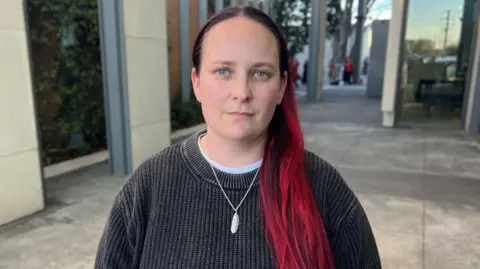A jury found Erin Patterson guilty on all charges – but the frenzy of speculation has only intensified.
The mushroom killer was obsessed with true crime. Now true crime fans are obsessed with her
For years, from behind a computer screen, Erin Patterson built up a reputation in an online true crime community as a “super sleuth”.
Today, she herself has become a true crime obsession.
When three people died – and another fell gravely ill – after eating toxic-mushroom-laced beef Wellingtons at her home in rural Victoria two years ago, her entire life was put under a microscope.
Journalists have descended from around the world to cover her lengthy murder trial, spectators have queued daily to nab a spot in the courtroom, and thousands of people have picked apart details of the case online.
But, despite a jury earlier this week finding her guilty on all charges, the frenzy of speculation and depth of fascination has only intensified.
“It has shades of Macbeth,” criminal psychologist Tim Watson-Munro told the BBC.
 Getty Images
Getty ImagesIt was in one of Australia’s smallest courtrooms that its biggest trial in recent history took place.
Over 11 weeks, seven documentary-making teams cast their lens on the tiny town of Morwell. Podcasters here were a dime a dozen. Journalists vied for the six seats reserved for media inside the court each day. Even one of Australia’s best-loved authors, Helen Garner, frequently dropped by the Latrobe Valley Law Courts, fuelling rumours that she is preparing to write another best-seller.
Waiting with the sea of tripods outside the building most mornings of the trial was a queue of camp chairs.
Come rain, frost or fog, court watchers – predominantly women, often rugged up in beanies and encased in sleeping bags – watched for the moment the glass doors would open.
Once inside, they would lay a line of belongings – scarves, water bottles, notepads, bags – outside the courtroom entry to reserve their spot.

Tammy Egglestone commuted for more than an hour to reach Morwell most days of the trial. “I’m a bit of a true crime fanatic,” she explains.
She was in court when it heard evidence that Patterson was once just like her.
Patterson had been an active member in a Facebook group focussed on the crimes of Keli Lane, a woman who was found guilty of killing her two-day-old daughter in one of Australia’s most notorious cases.
In 2018, Lane became the subject of a major podcast after writing to a journalist claiming to have been wrongly convicted and begging her to investigate.
At Patterson’s trial, one of her online friends Christine Hunt said she was renowned among her peers for her nimble researching and tech skills.
“She was a bit of a super sleuth,” she said. “She was highly regarded in that group.”
 Getty Images
Getty ImagesBut as her case unfolded in Morwell, Patterson was also put on trial in the court of public opinion.
She became water-cooler talk in workplaces around the country, gossip among friend groups, and the ultimate topic of debate online.
Thousands of people theorised over a motive for the crime, provided commentary on bits of evidence, and even alleged corrupt forces were behind the case – much of the discussion unfounded, almost all of it in breach of laws designed to give defendants a fair trial.
Memes filled social media feeds. On Google Maps, someone created a restaurant listing at Patterson’s home address. Others shared trial bingo cards they had created for those following it closely.
Throughout the week the jury was considering their verdict, sequestered in a hotel to protect them from the maelstrom, the question everyone had was: what were they thinking?
“What are they doing in there?” one lawyer was overheard asking in a Morwell café on day four of deliberations.

With jury members bound by strict secrecy requirements, we will never know.
“In the US, they can interview jurors after a trial,” criminal psychologist Tim Watson-Munro told the BBC. “We can’t get into the heads of jurors in Australia… so it’s really hard to know what they’re thinking has been and why they’ve come to that conclusion.”
That leaves a massive vacuum for members of the public to fill with their speculation.
People like Ms Egglestone pondered: if the poisoning was intended to kill, wouldn’t Patterson have planned and executed it better?
“I’ve come in here [as] Switzerland,” Ms Egglestone clarified, calling the discourse around the case “very pitchforky”.
“You know, [it’s] she’s guilty, she’s guilty, she’s guilty.
“And a lot of them are using hindsight reasoning. ‘If I was in that situation, I wouldn’t do this, this and this.’ Well, you don’t know what you would do in that situation.”
But people like her were drowned out by the hordes proclaiming Patterson guilty.
Many said it was her lies that convinced them. Some claimed the evidence showed a clear lack of empathy and concern for those who died.
“What really gave her away was wearing white pants when she had ‘gastro’ and needed to go to hospital for it!” one person posted, referring to CCTV footage of her movements in the days after the lunch, which was played at the trial.
Already, the case has inspired a television special, a silver screen drama series, a bevy of podcasts, several documentaries and a handful of books.
“It has those typical cliché things that make true crime sell,” Ms Egglestone said, explaining why she and flocks of others have become obsessed with the case.
“The fact that she did take out family members… [she’s] white, female, financially stable, you know. And they’re all church people.”
For David Peters, seemingly benign circumstances surrounding the crime – and the fact it was in his local area – drew him in: “The fact that it was a family sitting down to do something you would consider to be safe – have a meal – and then the consequences of that meal…”
Several people tell the BBC the case reminds them of the frenzy over Lindy Chamberlain’s notorious trial in 1982. She was falsely convicted of murder after her infant daughter Azaria was taken from an outback campsite by a dingo.
It’s no coincidence that both of those cases centre around women, criminology researcher Brandy Cochrane tells the BBC.
The world has long been fascinated by women who kill – in no small part because it contradicts their traditional “caring” gender role, they explain.
Those stereotypes also cast a shadow on Patterson’s time in court.
 EPA
EPA“She’s expected to act in a particular way, and she’s not,” says Dr Cochrane, a lecturer at Victoria University.
“It’s like, ‘Oh, obviously she’s guilty, she’s not crying the whole time’ or ‘Obviously she’s guilty, she’s lied about this’. The legal system in and of itself treats women very differently.”
Away from the ghoulish spectre of the trial, there’s anger – albeit dwindling – among the communities where the victims are from over the way the case has been dissected, local councillor Nathan Hersey tells the BBC.
Don and Gail Patterson and Heather Wilkinson were respected and adored by many in the South Gippsland region, he says, but it feels like they’ve been forgotten.
“This has been an extremely high-profile case that’s brought a lot of attention, often unwanted through to our local community.
“[And] some people haven’t had that humanity… they’ve certainly lost focus that for people, there is a loss, there is grief.”






